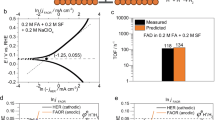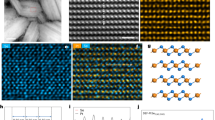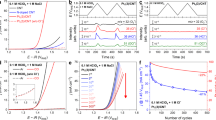Abstract
The electrochemical potential of a catalyst defines the free-energy landscape of catalysis in liquid media and is readily measured for catalysts supported on conductive materials or wired to external circuits. However, the potential is difficult to quantify for thermochemical catalysts supported on electrical insulators, thereby impeding a unifying understanding of the role of electrochemical polarization during thermochemical catalysis. Here we develop a methodology to quantify the electrochemical potential of metal catalysts supported on insulators by introducing low concentrations of redox-active molecules that establish wireless electrical connections between the catalyst and a sensing electrode. Using this approach in tandem with simultaneous rate measurements, we demonstrate distinct rate-potential scalings for oxidative dehydrogenation of formic acid on SiO2-supported and Al2O3-supported versus TiO2-supported Pt and find deactivation modes specific to SiO2-supported Pt. These developments enable the comprehensive investigation of the role of electrochemical polarization in thermochemical catalysis and complement the existing toolkit for mechanistic investigation in catalysis.

This is a preview of subscription content, access via your institution
Access options
Access Nature and 54 other Nature Portfolio journals
Get Nature+, our best-value online-access subscription
27,99 € / 30 days
cancel any time
Subscribe to this journal
Receive 12 digital issues and online access to articles
118,99 € per year
only 9,92 € per issue
Buy this article
- Purchase on SpringerLink
- Instant access to full article PDF
Prices may be subject to local taxes which are calculated during checkout








Similar content being viewed by others
Data availability
The data that support the findings of this study are included in the article and its Supplementary Information or from the corresponding author on reasonable request.
References
Shangguan, J. & Chin, Y.-H. C. Kinetic significance of proton−electron transfer during condensed phase reduction of carbonyls on transition metal clusters. ACS Catal. 9, 1763–1778 (2019).
Zhao, Z. et al. Solvent-mediated charge separation drives alternative hydrogenation path of furanics in liquid water. Nat. Catal. 2, 431–436 (2019).
Zope, B. N., Hibbitts, D. D., Neurock, M. & Davis, R. J. Reactivity of the gold/water interface during selective oxidation catalysis. Science 330, 74–78 (2010).
Cheng, G. et al. Importance of interface open circuit potential on aqueous hydrogenolytic reduction of benzyl alcohol over Pd/C. Nat. Commun. 13, 7967 (2022).
Wesley, T. S., Román-Leshkov, Y. & Surendranath, Y. Spontaneous electric fields play a key role in thermochemical catalysis at metal–liquid interfaces. ACS Cent. Sci. 7, 1045–1055 (2021).
Ryu, J. et al. Thermochemical aerobic oxidation catalysis in water can be analysed as two coupled electrochemical half-reactions. Nat. Catal. 4, 742–752 (2021).
Mallat, T. & Baiker, A. Catalyst potential measurement: a valuable tool for understanding and controlling liquid phase redox reactions. Top. Catal. 8, 115–124 (1999).
Adams, J. S., Kromer, M. L., Rodríguez-López, J. & Flaherty, D. W. Unifying concepts in electro- and thermocatalysis toward hydrogen peroxide production. J. Am. Chem. Soc. 143, 7940–7957 (2021).
Bockris, J. O., Reddy, A. & Gamboa-Aldeco, M. Modern Electrochemistry 2A: Fundamentals of Electrodics (Springer, 2000).
Tao, Q. et al. Interaction of C1 molecules with a Pt electrode at open circuit potential: a combined infrared and mass spectroscopic study. J. Phys. Chem. C 118, 6799–6808 (2014).
DiCosimo, R. & Whitesides, G. M. Oxidation of 2-propanol to acetone by dioxygen on a platinized electrode under open-circuit conditions. J. Phys. Chem. 93, 768–775 (1989).
Tokarev, A. V. et al. Kinetic behaviour of electrochemical potential in three-phase heterogeneous catalytic oxidation reactions. J. Mol. Catal. A 255, 199–208 (2006).
Qi, X. et al. Potential–rate correlations of supported palladium-based catalysts for aqueous formic acid dehydrogenation. J. Am. Chem. Soc. 146, 9191–9204 (2024).
Mallat, T. & Baiker, A. Oxidation of alcohols with molecular oxygen on platinum metal catalysts in aqueous solutions. Catal. Today 19, 247–283 (1994).
Sauvé, E. R. et al. Open circuit potential decay transients quantify interfacial pH swings during high current density hydrogen electrocatalysis. Joule 8, 728–745 (2024).
Vayenas, C. G. Bridging electrochemistry and heterogeneous catalysis. J. Solid State Electrochem. 15, 1425–1435 (2011).
Lodaya, K. M. et al. An electrochemical approach for designing thermochemical bimetallic nitrate hydrogenation catalysts. Nat. Catal. 7, 262–272 (2024).
Daniel, I. T. et al. Electrochemical polarization of disparate catalytic sites drives thermochemical rate enhancement. ACS Catal. 13, 14189–14198 (2023).
van der Plas, J. F. & Barendrecht, E. Electrocatalytic hydrogenation processes at controlled potential—3. Measurement of the catalyst potential. Electrochim. Acta 25, 1477–1480 (1980).
Howland, W. C., Gerken, J. B., Stahl, S. S. & Surendranath, Y. Thermal hydroquinone oxidation on Co/N-doped carbon proceeds by a band-mediated electrochemical mechanism. J. Am. Chem. Soc. 144, 11253–11262 (2022).
An, H., Sun, G., Hülsey, M. J., Sautet, P. & Yan, N. Demonstrating the electron–proton-transfer mechanism of aqueous phase 4-nitrophenol hydrogenation using unbiased electrochemical cells. ACS Catal. 12, 15021–15027 (2022).
Anson, C. W. & Stahl, S. S. Mediated fuel cells: soluble redox mediators and their applications to electrochemical reduction of O2 and oxidation of H2, alcohols, biomass, and complex fuels. Chem. Rev. 120, 3749–3786 (2020).
Stergiou, A. D. & Symes, M. D. Organic transformations using electro-generated polyoxometalate redox mediators. Catal. Today 384–386, 146–155 (2022).
Adams, J. S. et al. Solvent molecules form surface redox mediators in situ and cocatalyze O2 reduction on Pd. Science 371, 626–632 (2021).
Kummer, J. T. & Oei, D. G. A chemically regenerative redox fuel cell. J. Appl. Electrochem. 12, 87–100 (1982).
Westendorff, K. S., Hülsey, M. J., Wesley, T. S., Román-Leshkov, Y. & Surendranath, Y. Electrically driven proton transfer promotes Brønsted acid catalysis by orders of magnitude. Science 383, 757–763 (2024).
Hoque, M. A., Gerken, J. B. & Stahl, S. S. Synthetic dioxygenase reactivity by pairing electrochemical oxygen reduction and water oxidation. Science 383, 173–178 (2024).
Bates, J. S. et al. Chemical and electrochemical O2 reduction on earth-abundant M-N-C catalysts and implications for mediated electrolysis. J. Am. Chem. Soc. 144, 922–927 (2022).
To-A-Ran, W., Mastoi, N. R., Ha, C. Y., Song, Y. J. & Kim, Y.-J. Kelvin probe force microscopy and electrochemical atomic force microscopy investigations of lithium nucleation and growth: influence of the electrode surface potential. J. Phys. Chem. Lett. 15, 7265–7271 (2024).
Luo, B. et al. Triboelectric charge-separable probes for quantificationally charge investigating at the liquid-solid interface. Nano Energy 113, 108532 (2023).
Xu, X. et al. Electrochemical imaging of thermochemical catalysis. Preprint at ChemRxiv https://doi.org/10.26434/chemrxiv-2024-0ws9m (2024).
Zhao, Y. et al. Electrochemical screening of Au/Pt catalysts for the thermocatalytic synthesis of hydrogen peroxide based on their oxygen reduction and hydrogen oxidation activities probed via voltammetric scanning electrochemical microscopy. ACS Sustain. Chem. Eng. 10, 17207–17220 (2022).
Sun, Y., Dai, Y., Liu, Y. & Chen, S. A rotating disk electrode study of the particle size effects of Pt for the hydrogen oxidation reaction. Phys. Chem. Chem. Phys. 14, 2278–2285 (2012).
Durst, J., Simon, C., Hasché, F. & Gasteiger, H. A. Hydrogen oxidation and evolution reaction kinetics on carbon supported Pt, Ir, Rh, and Pd electrocatalysts in acidic media. J. Electrochem. Soc. 162, F190 (2015).
Roberts, J. A. S. & Bullock, R. M. Direct determination of equilibrium potentials for hydrogen oxidation/production by open circuit potential measurements in acetonitrile. Inorg. Chem. 52, 3823–3835 (2013).
Pope, M. T., Varga, G. M. J. & Heteropoly Blues, I. Reduction stoichiometries and reduction potentials of some 12-tungstates. Inorg. Chem. 5, 1249–1254 (1966).
Mallat, T., Bodnar, Z. & Baiker, A. Partial oxidation of water-insoluble alcohols over Bi-promoted Pt on alumina. Electrochemical characterization of the catalyst in its working state. Stud. Surf. Sci. Catal. 78, 377–384 (1993).
Conway, B. E. & Tilak, B. V. Behavior and characterization of kinetically involved chemisorbed intermediates in electrocatalysis of gas evolution reactions. Adv. Catal. 38, 1–147 (1992).
Batista, B. C. & Varela, H. Open circuit interaction of formic acid with oxidized Pt surfaces: experiments, modeling, and simulations. J. Phys. Chem. C 114, 18494–18500 (2010).
Fish, M. J. & Ollis, D. F. Characterization of enantioselective hydrogenation catalysts: transient electrochemical oxidation of d-(+)-tartaric acid on nickel. J. Catal. 50, 353–363 (1977).
Jürgensen, A. & Moffat, J. B. The stability of 12-molybdosilicic, 12-tungstosilicic, 12-molybdophosphoric and 12-tungstophosphoric acids in aqueous solution at various pH. Catal. Lett. 34, 237–244 (1995).
Michaelis, L. & Hill, E. S. The viologen indicators. J. Gen. Physiol. 16, 859–873 (1933).
Ito, M. & Kuwana, T. Spectroelectrochemical study of indirect reduction of triphosphopyridine nucleotide. I. Methyl viologen, ferredoxin-TPN-reductase and TPN. J. Electroanal. Chem. 32, 415–425 (1971).
Bird, C. L. & Kuhn, A. T. Electrochemistry of the viologens. Chem. Soc. Rev. 10, 49–82 (1981).
Venturi, M., Mulazzani, Q. G. & Hoffman, M. Z. Radiolytically-induced one-electron reduction of methyl viologen in aqueous solution: stability of the radical cation in acidic and highly alkaline media. Radiat. Phys. Chem. 23, 229–236 (1984).
Datta, M., Jansson, R. E. & Freeman, J. J. In situ resonance Raman spectroscopic characterization of electrogenerated methyl viologen radical cation on carbon electrode. Appl. Spectrosc. 40, 251–258 (1986).
Michaelis, L. Occurrence and significance of semiquinone radicals. Ann. N. Y. Acad. Sci. 40, 39–76 (1940).
Kütt, A. et al. Strengths of acids in acetonitrile. Eur. J. Org. Chem. 2021, 1407–1419 (2021).
Izutsu, K. Acid–Base Dissociation Constants in Dipolar Aprotic Solvents (Blackwell, 1990).
Pegis, M. L. et al. Standard reduction potentials for oxygen and carbon dioxide couples in acetonitrile and N,N-dimethylformamide. Inorg. Chem. 54, 11883–11888 (2015).
Chheda, J. N., Huber, G. W. & Dumesic, J. A. Liquid-phase catalytic processing of biomass-derived oxygenated hydrocarbons to fuels and chemicals. Angew. Chem. Int. Ed. 46, 7164–7183 (2007).
Guo, Z. et al. Recent advances in heterogeneous selective oxidation catalysis for sustainable chemistry. Chem. Soc. Rev. 43, 3480–3524 (2014).
Peper, J. L., Gentry, N. E., Boudy, B. & Mayer, J. M. Aqueous TiO2 nanoparticles react by proton-coupled electron transfer. Inorg. Chem. 61, 767–777 (2022).
Freund, M. S. & Lewis, N. S. Irreversible electrocatalyic reduction of V(V) to V(IV) using phosphomolybdic acid. Inorg. Chem. 33, 1638–1643 (1994).
Oh, H. et al. Phosphomolybdic acid as a catalyst for oxidative valorization of biomass and its application as an alternative electron source. ACS Catal. 10, 2060–2068 (2020).
Tanaka, N., Unoura, K. & Itabashi, E. Voltammetric and spectroelectrochemical studies of dodecamolybdophosphoric acid in aqueous and water-dioxane solutions at a gold-minigrid optically transparent thin-layer electrode. Inorg. Chem. 21, 1662–1666 (1982).
Flaherty, D. W. & Bhan, A. Improving the rigor and reproducibility of catalyst testing and evaluation in the laboratory. J. Catal. 431, 115408 (2024).
Baz, A. & Holewinski, A. Predicting macro-kinetic observables in electrocatalysis using the generalized degree of rate control. J. Catal. 397, 233–244 (2021).
Lović, J. D. et al. Kinetic study of formic acid oxidation on carbon-supported platinum electrocatalyst. J. Electroanal. Chem. 581, 294–302 (2005).
Zhu, X. & Huang, J. Modeling electrocatalytic oxidation of formic acid at platinum. J. Electrochem. Soc. 167, 13515 (2020).
Baddour, R. F., Modell, M. & Goldsmith, R. L. Palladium-catalyzed carbon monoxide oxidation. Catalyst ‘break-in’ phenomenon. J. Phys. Chem. 74, 1787–1796 (1970).
Xu, P., Bernal-Juan, F. D. & Lefferts, L. Effect of oxygen on formic acid decomposition over Pd catalyst. J. Catal. 394, 342–352 (2021).
Ide, M. S., Falcone, D. D. & Davis, R. J. On the deactivation of supported platinum catalysts for selective oxidation of alcohols. J. Catal. 311, 295–305 (2014).
Acknowledgements
We thank the entire Surendranath Lab for their support and scientific discussions. This work was supported by the Gordon and Betty Moore Foundation, under grant ID: GBMF11510 (https://doi.org/10.37807/GBMF11510). N.K.R. is grateful for the generous support from the Arnold O. Beckman Postdoctoral Fellowship. K.S.W. acknowledges support from the National Science Foundation Graduate Research Fellowship under Grant No. 174530.
Author information
Authors and Affiliations
Contributions
N.K.R. and Y.S. conceived the research and developed the experiments. N.K.R. conducted the majority of the experiments. K.S.W. conducted characterization experiments, O2 reaction order experiments and contributed to data analysis. N.K.R., K.S.W. and Y.S. wrote the paper.
Corresponding author
Ethics declarations
Competing interests
The authors declare no competing interests.
Peer review
Peer review information
Nature Catalysis thanks Steven McIntosh, Kotaro Takeyasu and Bin Zhang for their contribution to the peer review of this work.
Additional information
Publisher’s note Springer Nature remains neutral with regard to jurisdictional claims in published maps and institutional affiliations.
Supplementary information
Supplementary Information
Supplementary Figs. 1–24, Tables 1 and 2 and references.
Rights and permissions
Springer Nature or its licensor (e.g. a society or other partner) holds exclusive rights to this article under a publishing agreement with the author(s) or other rightsholder(s); author self-archiving of the accepted manuscript version of this article is solely governed by the terms of such publishing agreement and applicable law.
About this article
Cite this article
Razdan, N.K., Westendorff, K.S. & Surendranath, Y. Wireless potentiometry of thermochemical heterogeneous catalysis. Nat Catal 8, 315–327 (2025). https://doi.org/10.1038/s41929-025-01308-7
Received:
Accepted:
Published:
Issue Date:
DOI: https://doi.org/10.1038/s41929-025-01308-7
This article is cited by
-
Revealing hidden nanoscale electrocatalysis
Nature Catalysis (2025)



